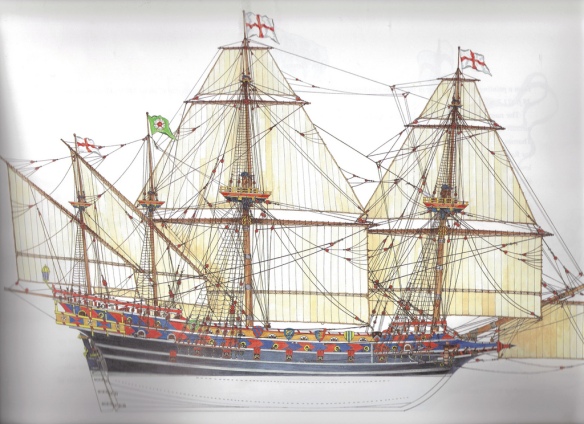
English Race-built Galleon
As late as the summer of 1587 Elizabeth was still trying to negotiate peace with Spain. Her commissioners discussed terms with the commander of the Spanish forces in the Netherlands, Alessandro Farnese, Duke of Parma and Piacenza (1545–1592). In the spring of 1588 a dismayed Elizabeth learned that Philip had designated his daughter as the rightful queen of England. She began preparations for a Spanish attack.
Every soldier and statesman in England understood that if Spanish troops were able to successfully invade English shores, England could not win a land battle. There were only a few hundred professional soldiers scattered throughout the whole nation. In an invasion, local militias, or groups of volunteers, would be responsible for defending most of the country. Hastily formed and mostly unarmed and untrained, these militias could not win against the superior armies of Spain. In fact it would have been nearly impossible to protect every port in England from invasion, and no one knew where Philip intended to attack.
England had a small but outstanding navy, thanks largely to Elizabeth’s father, Henry VIII (1491–1547). At his death the English navy included fifty-three warships. They were expensive to maintain, though, and by the time of Mary I’s reign, the navy had diminished to thirty ships. Philip, as Mary’s husband, had argued strongly in favor of building up England’s navy, considering it the country’s best means of defense. He could not have foreseen that, thirty years later, Spain would be battling the very ships he had advocated.
Since becoming Queen Elizabeth had devoted her resources to maintaining and building up the English navy. According to most historians she made a brilliant choice in her 1578 appointment of the former slavetrader and privateer John Hawkins (1532–1595) as treasurer of the navy. Hawkins developed a new kind of warship that was much lighter, faster, and easier to operate than earlier ships. He trained a small, elite group of highly skilled and motivated sailors, giving them better working conditions and higher wages in return for top performance. Hawkins, more than anyone else, was responsible for making the English fleet the most modern navy in the world. Elizabeth’s navy numbered about thirty-four ships in 1588, and thirty private vessels armed for battle also volunteered to fight the Spanish Armada.
Elizabeth chose talented commanders for the English fleet. The top command was given to her cousin, Admiral Lord (Charles) Howard of Effingham (1536–1624). Second in command officers included Francis Drake, John Hawkins, and explorer and privateer Martin Frobisher (c. 1535–1594), among others. Lord Howard had the least amount of sea experience, but he was an outstanding commander who knew how to utilize the skills and experience of his captains.
English strategy in a naval battle was simple. They knew they could not compete in hand-to-hand combat with the skilled Spaniards, who would try to board their ships. To avoid being boarded, the English fleet prepared to use long-range cannons to fire at the Spanish ships from a safe distance. Elizabeth gave the commanders of the fleet the authority to make all decisions during battle.